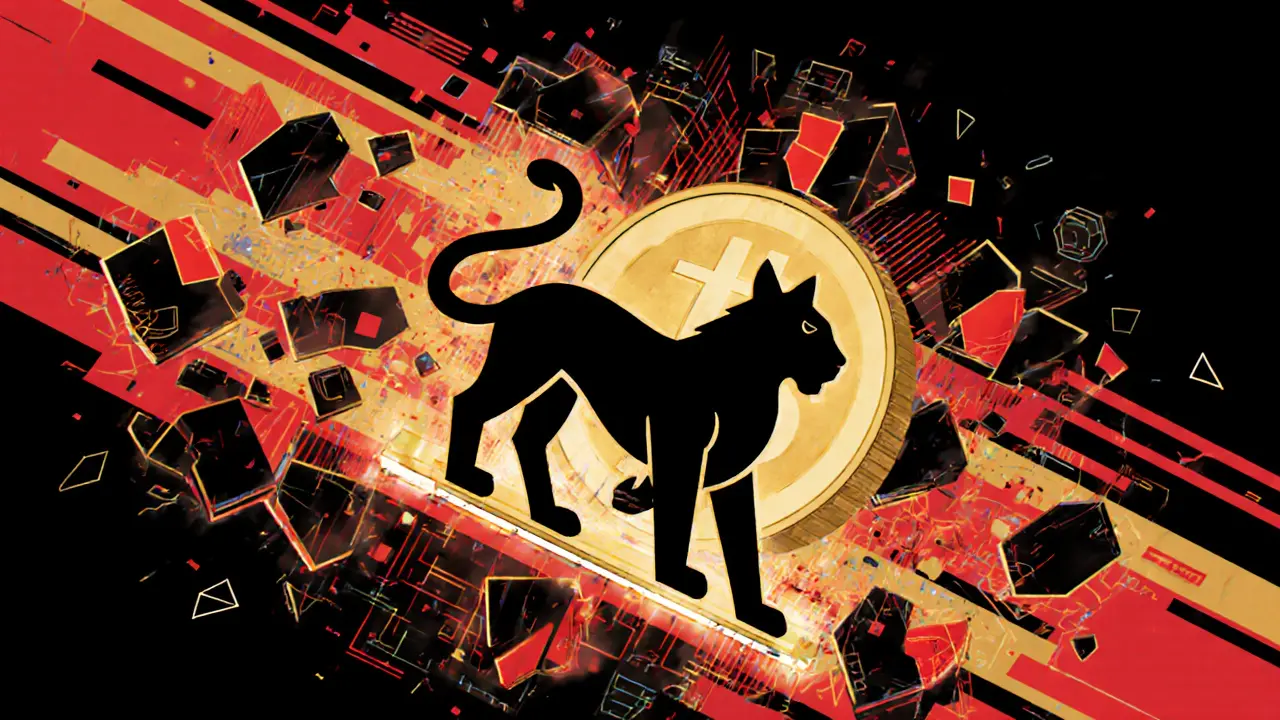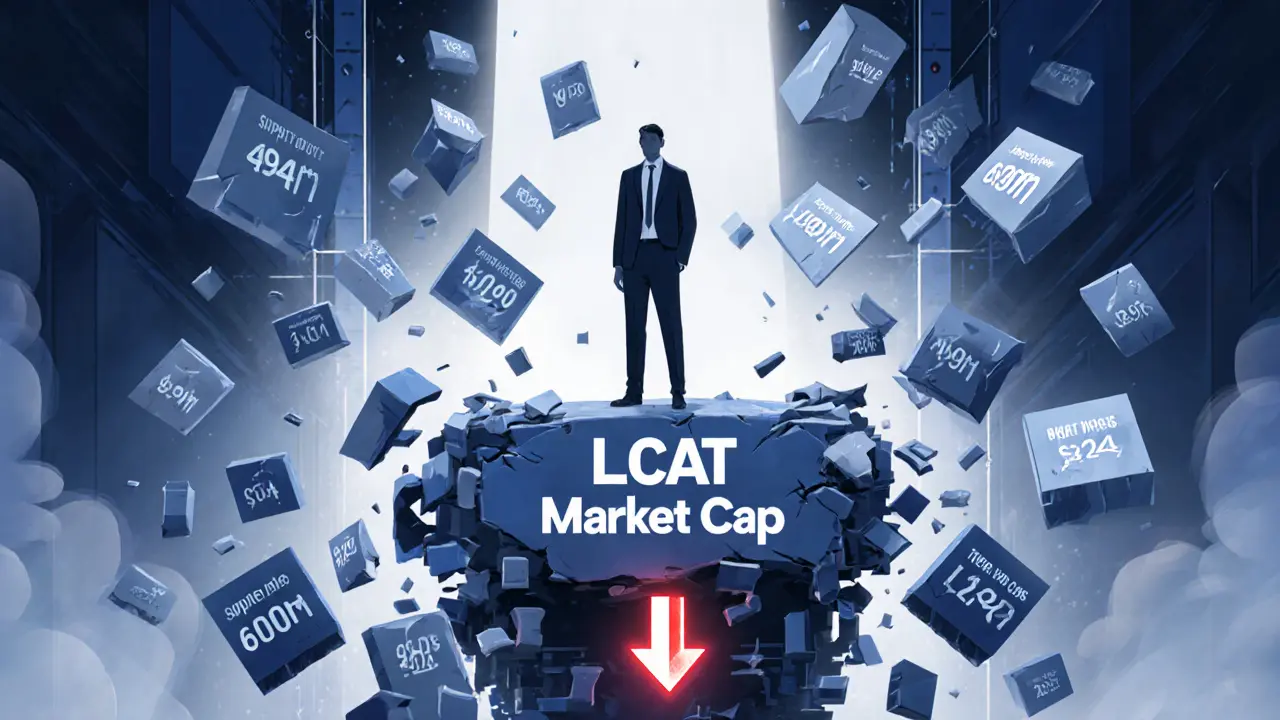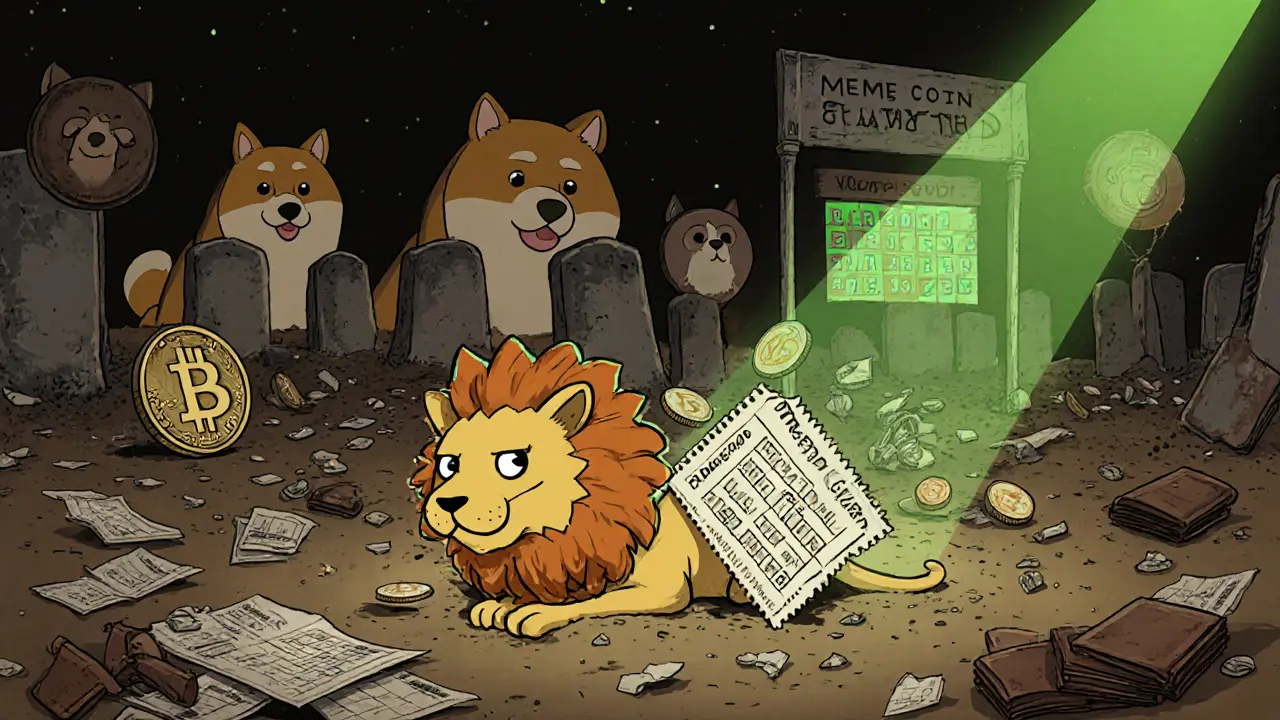What is Lion Cat (LCAT) crypto coin? Price, supply, and what you need to know
 Sep, 6 2025
Sep, 6 2025
LCAT Market Cap Calculator
LCAT Market Cap Calculator
Calculate LCAT's market cap using your price estimate. Note: Actual supply numbers vary between sources (494M to 600M tokens).
Enter values above to see market cap calculation
Important: Supply data varies significantly between sources (494M vs 600M tokens). This tool shows the market cap range based on these discrepancies. Market cap = price × circulating supply.
Lion Cat (LCAT) is a meme cryptocurrency token built on the BNB Smart Chain, designed to appeal to crypto enthusiasts who enjoy high-risk, community-driven projects. Unlike traditional cryptocurrencies with clear utility or technical innovation, LCAT exists primarily as a speculative asset fueled by social media buzz and trader sentiment. It doesn’t solve a problem, power a decentralized app, or offer governance. Instead, it leans into the meme coin culture - think Dogecoin or Shiba Inu - but with a smaller, less visible community.
How Lion Cat (LCAT) works
LCAT is a BEP-20 token, which means it runs on the BNB Smart Chain - the same blockchain that powers Binance’s ecosystem. This gives it some practical advantages: transactions are faster and cheaper than on Ethereum. A typical LCAT transfer costs less than a penny in gas fees, making it easy for small traders to buy, sell, or swap without getting crushed by network costs.
There’s no mining, no staking rewards, and no official roadmap. The project doesn’t claim to have a team or whitepaper. Its entire value proposition is built on community identity - the idea that holding LCAT means you’re part of a bold, adventurous group of crypto traders. That’s it. No token burns, no treasury, no planned partnerships. It’s a pure play on hype and momentum.
Current price and market data
As of November 2025, LCAT’s price varies across platforms, which is normal for low-cap tokens. CoinMarketCap lists it at $0.01076, CoinCodex at $0.011688, and CoinStats at $0.009322. SwapSpace shows it near $0.01216. These differences come from which exchanges each site pulls data from - some track smaller, less liquid markets, others use larger ones.
The 24-hour trading volume hovers around $38,000, which is tiny compared to top meme coins like Dogecoin (which trades over $500 million daily). That low volume means even small buy or sell orders can swing the price sharply. One minute, it’s up 10%; the next, it’s down 15%. That’s not a bug - it’s the nature of the asset.
Supply confusion - why numbers don’t match
One of the biggest red flags for LCAT is the conflicting supply figures. SwapSpace says 600 million LCAT tokens are in circulation. CoinStats says only 494 million are circulating. That’s a difference of over 100 million tokens - roughly 20% of the total.
This kind of mismatch usually means one of three things: some tokens are locked in wallets that aren’t counted, others were burned (destroyed) but not updated on all trackers, or one of the sources is outdated. Without an official source from the LCAT team - like a verified website or blockchain explorer - you can’t know which number is accurate. And that’s dangerous. Market cap is calculated by multiplying price by circulating supply. If the supply number is wrong, so is the market cap.
Some sites list LCAT’s market cap around $4.6 million. Others show less. That kind of uncertainty makes it nearly impossible to compare LCAT fairly with other coins or judge whether it’s overvalued or undervalued.

Technical indicators - what they tell you
Looking at technical data gives a clearer picture of recent behavior. The 50-day moving average is $0.012034, while the 200-day average is $0.040294. That gap tells you LCAT has lost more than 75% of its value since its peak. It’s not in a bull run - it’s in a long, slow decline.
The RSI (Relative Strength Index) sits at 50.23, which is neutral. No strong buying or selling pressure right now. The Fear and Greed Index is 48 - also neutral. That means traders aren’t panicking or getting greedy. They’re just waiting.
Over the last 30 days, 14 were green (up) days - just under half. Volatility is at 8.61%, which is high for a coin this size. That means price swings of 8% or more in a single day are common. If you’re not ready for that kind of ride, LCAT isn’t for you.
Price predictions - are they real?
Some sites claim LCAT could hit $0.02 by 2025 or even $0.024 by 2026. WalletInvestor says it might reach $0.0241. But they also warn it could drop to $0.0098. That’s a 60% swing either way.
These predictions aren’t forecasts - they’re math models based on past price patterns. They don’t account for real-world events, team activity, or adoption. For a coin with no team, no utility, and no exchange listings beyond a few small ones, those models are basically guessing.
Compare that to Dogecoin, which got a boost from Elon Musk’s tweets. Or Shiba Inu, which got listed on Coinbase and Binance. LCAT has none of that. No celebrities. No big exchanges. No media coverage. If you’re betting on LCAT, you’re betting on pure luck.

Where does LCAT stand among meme coins?
There are hundreds of meme coins on BNB Smart Chain. Most die within months. Only a few - like Dogecoin, Shiba Inu, and Pepe - survive because they got massive attention early on. LCAT is nowhere near that level.
On CoinMarketCap, it’s ranked #1475. That means there are 1,474 other cryptocurrencies with higher market caps. Most of those are legitimate projects with teams, products, or users. LCAT is just a token with a lion and a cat logo.
It doesn’t have a Discord server with thousands of members. It doesn’t trend on Twitter. It doesn’t have influencers pushing it. The community is quiet. That’s not a sign of strength - it’s a sign of weakness.
Should you buy Lion Cat (LCAT)?
If you’re looking for a long-term investment, the answer is no. LCAT has no fundamentals. No utility. No roadmap. No team. It’s not going to change the world. It’s not even going to change your portfolio in a meaningful way.
If you’re looking for a short-term gamble - something you can buy for a few dollars, hold for a week, and maybe cash out for double - then maybe. But only if you treat it like a lottery ticket. Set a limit. Don’t go over $50. Don’t chase losses. And be ready to lose it all.
Most people who trade LCAT lose money. The ones who win are either lucky or got in early - before the price dropped 80%. If you’re reading this now, you’re probably late.
Final thoughts
Lion Cat (LCAT) is a classic example of a meme coin with no future beyond speculation. It’s not a scam - it doesn’t pretend to be anything else. But it’s also not an investment. It’s entertainment with risk.
Before you buy, ask yourself: Are you buying because you believe in the project? Or because you hope someone else will pay more for it next week?
If it’s the latter, you’re already in the right place. Just don’t expect anything more than a wild ride - and be prepared to get off before the crash.
Is Lion Cat (LCAT) a good investment?
No, Lion Cat is not a good investment. It has no utility, no team, no roadmap, and no real adoption. Its value comes entirely from speculation and meme culture. Most small-cap meme coins like LCAT lose value over time. If you buy it, treat it like gambling - not investing.
Where can I buy LCAT crypto?
You can buy LCAT on decentralized exchanges (DEXs) that support BNB Smart Chain, like PancakeSwap. It’s not listed on major centralized exchanges like Binance, Coinbase, or Kraken. That limits liquidity and makes it harder to trade safely. Always use a trusted wallet like MetaMask and double-check the contract address before swapping.
Why do different websites show different prices for LCAT?
LCAT trades on multiple small exchanges, each with different trading volumes and order books. Price trackers like CoinMarketCap and CoinGecko pull data from different sources, which causes discrepancies. Also, low trading volume means even small trades can shift the price. Always check multiple sources and use the most liquid exchange for accurate pricing.
What’s the total supply of LCAT?
There’s no official confirmation. SwapSpace says 600 million, CoinStats says 494 million. The difference could be due to burned tokens, locked wallets, or outdated data. Without a verified source from the project, you can’t trust any number. This uncertainty is a major risk - always verify supply before calculating market cap.
Can LCAT reach $0.10 or $1 in the future?
It’s extremely unlikely. For LCAT to reach $0.10, its market cap would need to jump to over $49 billion - bigger than Ethereum. That would require massive adoption, exchange listings, and community growth - none of which exist. Predictions claiming LCAT will hit $0.10 or $1 are pure fantasy. Stick to realistic numbers based on current trends.
Is LCAT built on Ethereum?
No, LCAT runs on the BNB Smart Chain (BSC), not Ethereum. That means lower transaction fees and faster confirmations. But it also means you need BNB in your wallet to pay for gas. You can’t use ETH to trade LCAT - you must use BNB or swap via a DEX like PancakeSwap.
Does LCAT have a whitepaper or development team?
No. There is no official whitepaper, no published team members, and no public development updates. LCAT follows the classic meme coin model: anonymous launch, community-driven hype, no long-term plans. That’s not inherently bad - but it means there’s zero accountability. If the price crashes, no one is responsible.
How volatile is LCAT compared to other meme coins?
LCAT is more volatile than top meme coins like Dogecoin or Shiba Inu because it has much lower trading volume. High volatility means bigger price swings in short periods. LCAT’s 8.61% daily volatility is high for its size. You could lose 20% in a day - or gain it. That’s normal for small meme coins, but dangerous if you’re not prepared.
Sunidhi Arakere
November 7, 2025 AT 14:18Lion Cat is just a fun little gamble. I put in $20, didn’t check for a month, and it’s still there. No stress, no expectations. If it goes up, nice. If it vanishes, oh well. Meme coins are like candy - sweet, temporary, and best enjoyed in small doses.
Vivian Efthimiopoulou
November 9, 2025 AT 05:04The true tragedy of LCAT is not its lack of utility, but the illusion of agency it bestows upon its holders. We are not investors - we are participants in a collective ritual of hope, where the altar is a smart contract and the offering is our financial discretion. The blockchain does not care if we believe. It only records. And yet, we return, again and again, drawn by the siren song of the next 10x - a modern-day Sisyphus, pushing a token up a hill made of gas fees.
Angie Martin-Schwarze
November 9, 2025 AT 13:00ok so i just bought 500k lcat bc why not?? i mean its only 5 bucks right?? also i think the lion is kinda cute?? like i dont even know what i’m doing but i feel like i’m part of something?? 🤷♀️😂
Fred Kärblane
November 9, 2025 AT 16:55LCAT is a pure play on liquidity arbitrage within the BSC ecosystem. With sub-penny pricing and low market cap, it’s an ideal vehicle for micro-cap momentum trading. The volatility profile - 8.61% daily - aligns with high-frequency sentiment-driven alpha generation. If you’re not leveraging MEV bots or using a DEX aggregator with slippage control, you’re already playing with house money.
Janna Preston
November 11, 2025 AT 07:15I don’t get why people are so scared of meme coins. I mean, if you’re only risking $10, what’s the harm? I bought some just to see what all the fuss is about. It’s like collecting trading cards - except these cards can make you rich or lose you lunch money. Either way, it’s interesting to watch.
Meagan Wristen
November 11, 2025 AT 23:10It’s kind of beautiful, really - how something so simple, so silly, can bring people together. No whitepaper, no team, no grand vision - just a lion and a cat, and a whole lot of people feeling like they belong. Maybe that’s the real utility. Not the price. Not the supply. But the quiet, weird community that shows up anyway. I’ve never met anyone who lost money on LCAT and didn’t smile while saying it.
Becca Robins
November 13, 2025 AT 07:02lol imagine thinking this coin has a future 😭 the supply numbers dont even match and people are still buying?? like… chill. its a joke. but a funny one. 🦁🐱💸
Alexa Huffman
November 15, 2025 AT 06:09For anyone considering LCAT, always verify the contract address on BscScan before trading. I’ve seen copycat tokens with similar names that drain wallets. The real LCAT contract starts with 0x7c...f8 - double-check it. And never send ETH. You need BNB for gas. Simple, but critical.
gerald buddiman
November 16, 2025 AT 01:30Wait… so there’s NO TEAM?!?! No whitepaper?!?! And people are STILL trading this?!?! I mean… I get the meme thing… but this feels like handing cash to a stranger on the street who says ‘trust me, this lottery ticket will win’… and then you find out the ticket was printed on a napkin… and the lottery doesn’t even exist… WHY?!?!?!?!?!
Arjun Ullas
November 16, 2025 AT 08:36LCAT exemplifies the dangers of retail speculation in unregulated decentralized markets. With a circulating supply discrepancy exceeding 20%, and no transparent audit or verified smart contract, the token constitutes a material information asymmetry. Investors must recognize that market cap calculations based on unverified supply are statistically invalid. This is not investing - it is financial experimentation without safeguards.
Steven Lam
November 17, 2025 AT 09:13why are people so mad about this coin its not even a scam its just a dumb token who cares if it goes to zero its not like you lost your house
Noah Roelofsn
November 18, 2025 AT 07:48LCAT is the crypto equivalent of a haunted house ride at a county fair - you know it’s not real, you know the scares are staged, but you still scream anyway because the thrill is in the ride. The price swings? The supply chaos? The complete absence of fundamentals? That’s not a bug - it’s the whole damn carnival. Buy in with laughter, not hope. And when the lights come on, walk away smiling. That’s the only profit that matters.